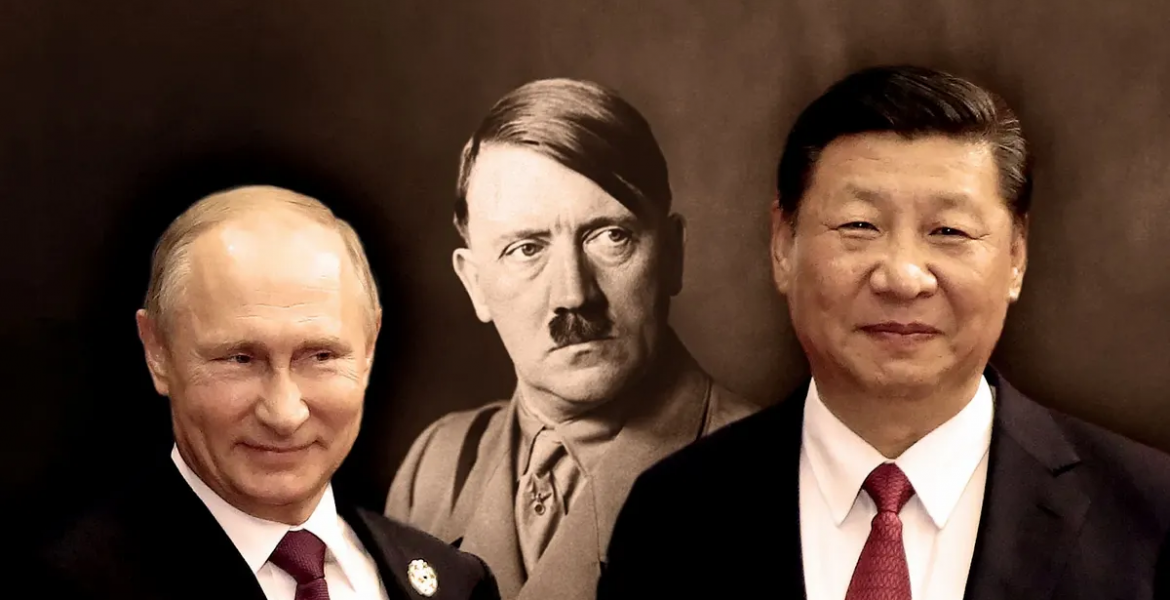What do the totalitarian policies of the Third Reich 80 years ago have in common with the modern imperial dimension of the Kremlin?
In 2008 in an interview with Die Welt, the political scientist Zbigniew Brzezinski equated the foreign policy of the then Prime Minister of Russia Vladimir Putin with the actions of Hitler in the 1930s. According to Brzezinski, the justification of war crimes in Georgia on the pretext of protecting Russian citizens living in South Ossetia can be compared to how the Nazis alleged the oppression, and persecution of ethnic Germans in the Sudetenland as a reason for the 1938 invasion of Czechoslovakia.
Vaclav Havel, the former president of the Czech Republic, said in an interview: “The desire to become great was inherent in both fascists and communists, and so did ancient empires. Take the example of the Ottoman or Roman Empire. They occupied and controlled vast territories, but their rulers were convinced that their states should continue to expand.”
Havel concluded: “The reasons for spreading their influence among the nearest neighbours may be radically different, but they are all basically similar to each other.”
Nothing in history is ever repeated exactly, but every historical event has an analogue that repeats the past. The only difference is in the strategic goals and the ideological doctrines. The common desire for world domination is identical, and the propaganda is just as gross.
Radical changes, the transformation of a political regime into a totalitarian dictatorship, begins with the presidency of one dominant party. Party affiliation becomes mandatory. The mantra often repeated is: “those who are not with us, are against us.” The next stage is the loss of civil society. The lack of a liberal opposition suffocates a country under an authoritarian system.
People become an amorphous intimidated mass, ready to bow to the will of the leader. Opposition parties are banned, the most ardent dissidents are repressed or physically destroyed. This is what happened in Germany in the early 1930s, and it is these same processes that are today’s reality in Russia.
Hitler at first tried to project the impression of a peaceful ruler, captivating the eyes of the world by staging the Olympics in Germany in 1936. Then he managed to mislead many, because the spectre of anti-Semitism was always present. In a similar vein Putin promotes “humane” narratives for the protection of Russian-speaking citizens around the world, and claims to defend the cultural heritage of the Soviet Union.
Freedom of speech, the press, and private property were illusory for Germany in the 1930s. This is again reflected today in Russia. There is a ban on most social networks, the opposition media is being forced out of business, and repression has destroyed the media sector.
Putin’s aggressive attitude towards Ukrainians with an aversion to everything native, authentic, and nationalistic is reminiscent of Hitler’s pathological disdain for national minorities, including Jews. The so-called “denazification” in Ukraine demanded by the Kremlin leader is tantamount to the first stage of genocide. How can a third country demand an independent European state to destroy its own attributes of national self-identification and self-consciousness?
There are similarities between the embittered, traumatic biographical history of Hitler and Putin, their use of propaganda, and their methods of retaining power. Whist these may go unnoticed by many, there are clear parallels:-
- formation of blind admiration by the people of the dictator’s actions;
- imposing an ingrained cult of personality in the state, which will last until the death of the “leader”;
- blocked channels of access to truthful information;
- incessant cynical lies by trained Cerberus propagandists (M. Simonyan, O. Skabeeva, V. Solovyov, T. Kandelaki and others);
- sabre rattling at military parades;
- the use of “St. George ribands” and slogans “grandfathers fought”;
- ruthless methods to dispose of anyone who challenges or stands in the way of the ambitions of the totalitarian leader;
- the use of similar rhetoric during speeches, individual combinations of words and copying charismatic techniques to influence different segments of the population;
- the use of unbridled terror as a tool for maintaining power and expanding territories;
- reporting their own history and management decisions with blatant lies, presented as sacred truth for their chosen cells;
- brazen positioning of the Russian Federation as a superpower, which has a parallel with Hitler’s generation of standards of the “Aryan race” and the rejection of their defined “minorities” (democracy = shameful form of government);
- callous experimentation with any type of weapon against the civilian population to win at all costs without regard to the humanitarian consequences;
- vindictive ideas of political and military revenge;
- brainwashing acolytes with a warped view of the world;
- interference in the internal affairs of other states;
- dictatorial approach to the arms race and paranoid attitude towards other alliances and their representatives (EU, NATO, USA);
- implementation of plans for subversive activities and external expansion of neighbouring states “for defense purposes”;
- occupying and annexing the territories of contrived “enemy” states;
- pursuing racist policies aimed at so-called “pure-blooded” Ukrainians without any right to their own nationality: “Little Russians”, “slaves”, “Bandera”, “fascists”, “anti-Semites”;
- continued broadcasting from the “bunker” to the fascist elite of desperate hopes for victory, when it is clear that they are staring at the jaws of defeat.
Putin may not be a total reincarnation of Hitler, but we cannot ignore the fact that there are too many similarities in the actions and propaganda of these two dictators for comfort. The world would be foolish to turn a blind eye to this. We should never forget the lessons of history if we are to avoid repeating a catastrophic outcome.




